Abstract
A register based study was conducted on the pregnancy outcome of female workers in eight Finnish pharmaceutical factories to determine whether they had a higher risk of spontaneous abortion than the general population or matched controls. Information about all female workers who had been employed in the factories during the years 1973 or 1975 (four factories) to 1980 was obtained from the employers. The workers' pregnancy data were collected from the nation wide hospital discharge register and polyclinic data of hospitals from 1973 to 1981. The total number of 1795 pregnancies included 1179 deliveries, 142 spontaneous abortions, and 474 induced abortions. The spontaneous abortion rate (the number of spontaneous abortions X 100, divided by the number of spontaneous abortions plus the number of births) during employment was 10.9% and before/after employment 10.6%. The rate for all the women in the corresponding central hospital districts was 11.3% [corrected] during the study period. A case-control study was also carried out in which the cases were 44 women who had a spontaneous abortion during employment in the pharmaceutical factory. Three age matched female pharmaceutical factory workers who had given birth to a child were chosen as controls for every case. The information about occupational exposures was collected from questionnaires completed by the occupational physician or nurse at the factory. The response rate was 93%. Exposure to chemicals was more common among the cases than among the controls. For methylene chloride, a solvent commonly used in the pharmaceutical industry, the increase in odds ratio of borderline significance (odds ratio 2.3, p = 0.06). In a logistic regression model (which included oestrogen exposure, solvent exposure frequency of the usage, and heavy lifting) the odds ratio was increased for oestrogens (odds ratio 4.2, p = 0.05) and for continuous heavy lifting (odds ratio 5.7, p = 0.02). The odds ratio for spontaneous abortions was greater among those exposed to four or more solvents (odds ratio 3.5, p=0.05) than among those exposed to one to three solvents (odds ration 0.8, p=0.74).
Full text
PDF
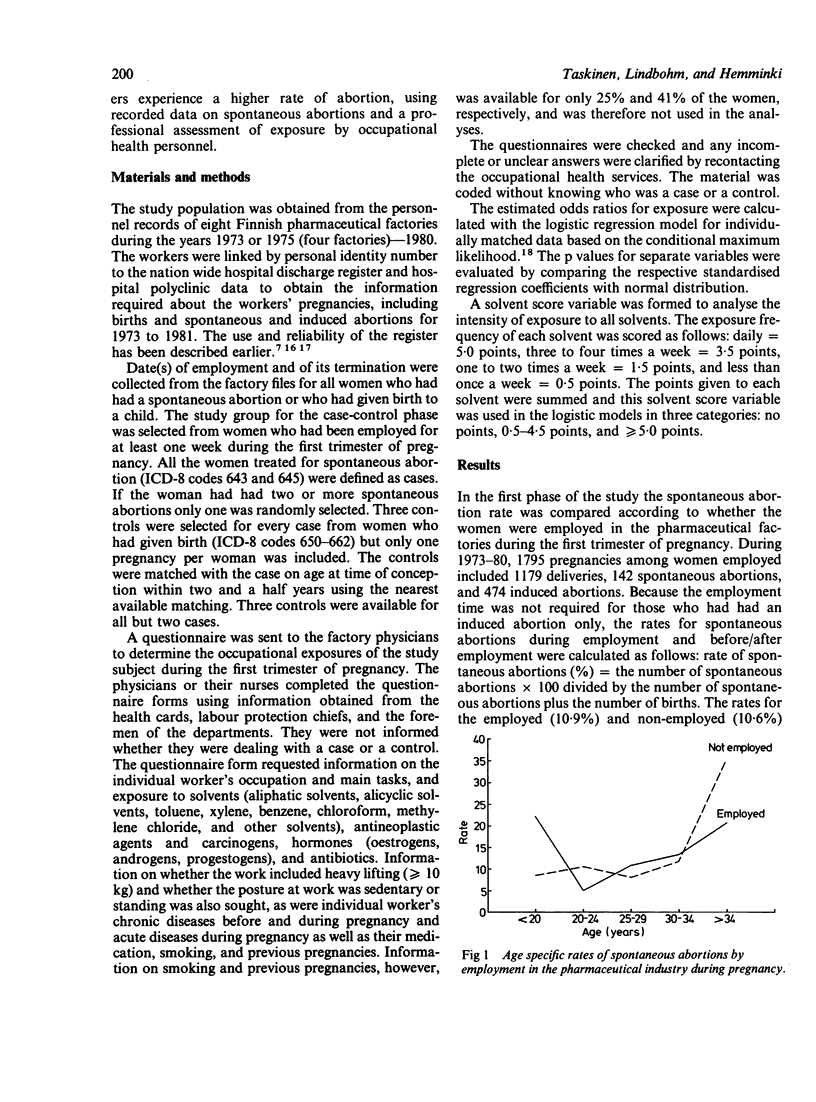

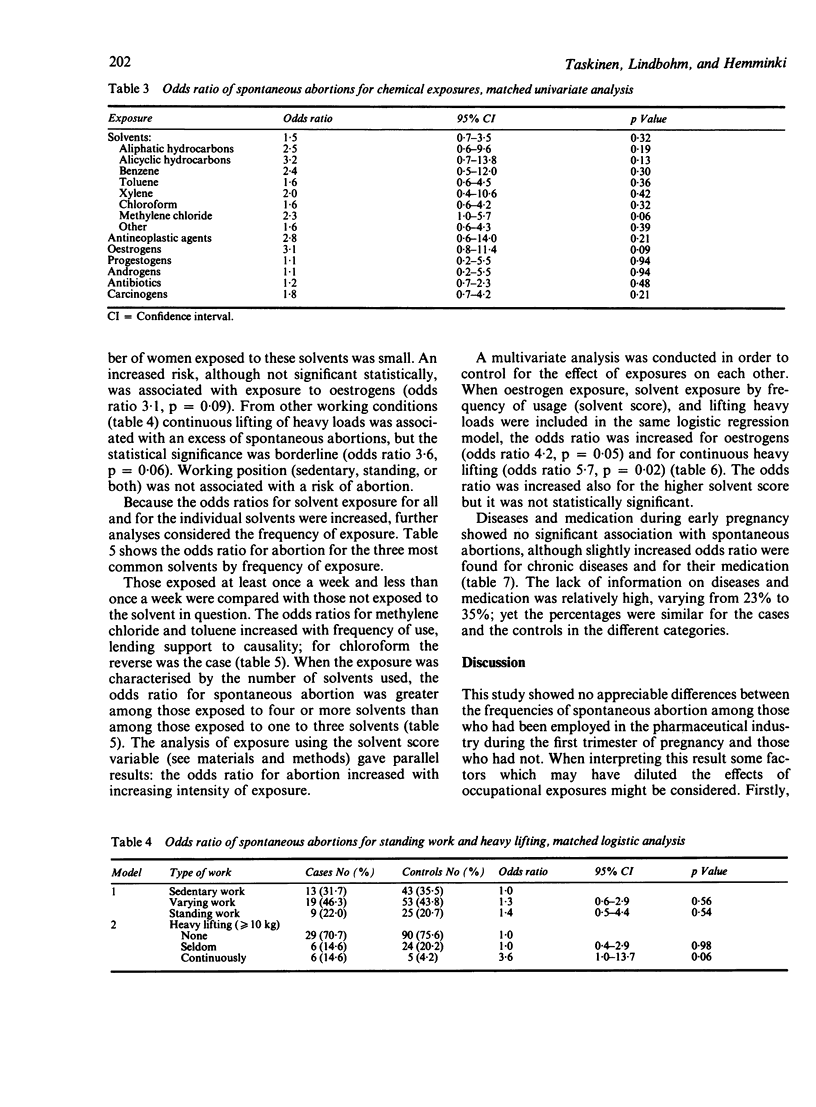
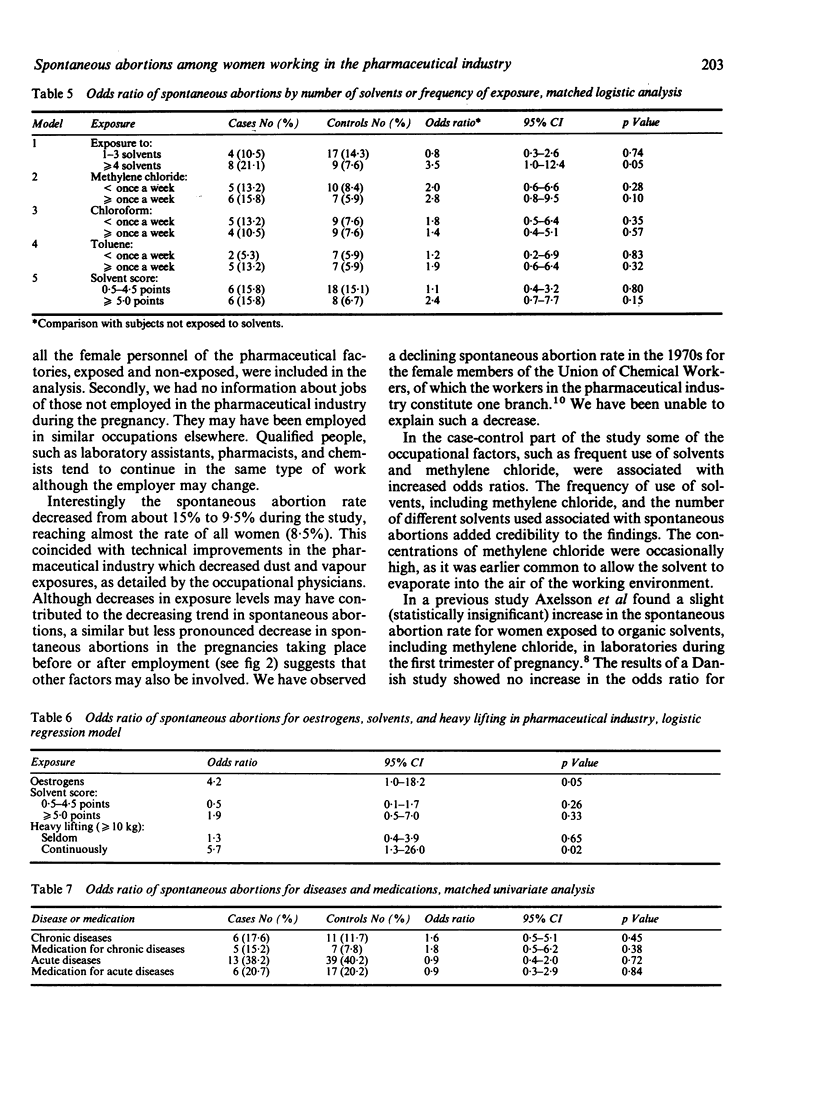
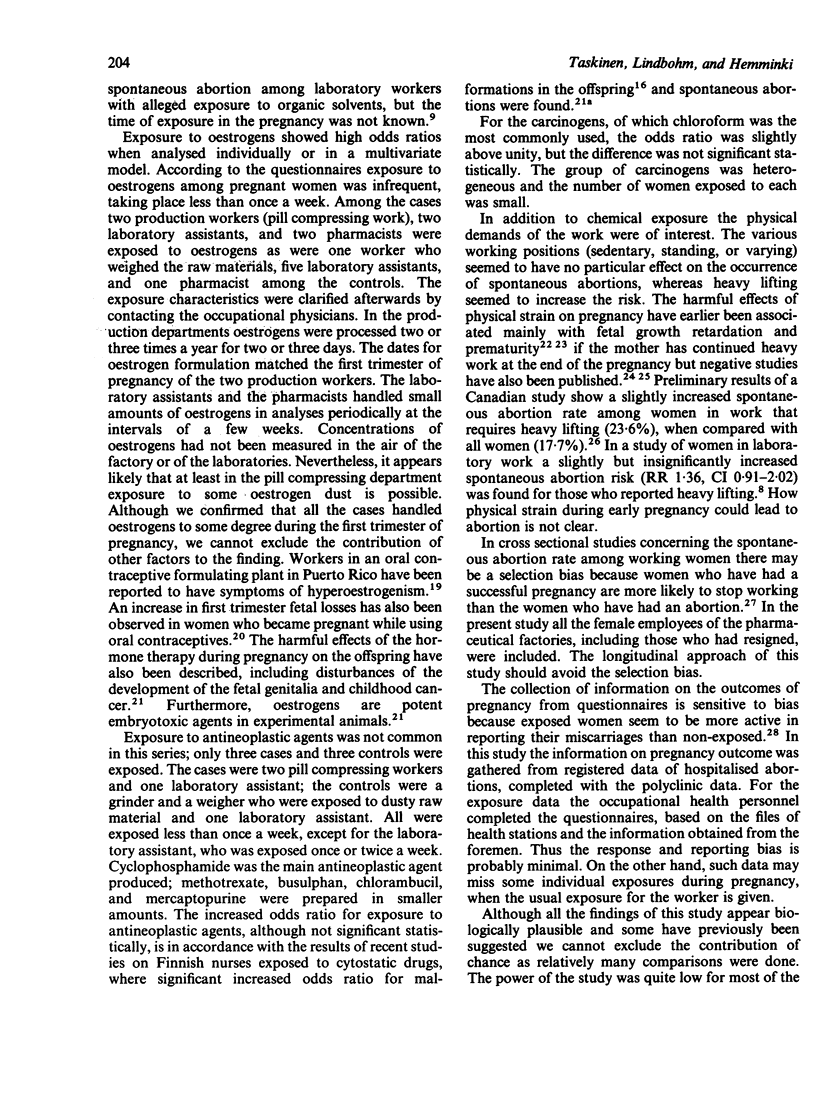
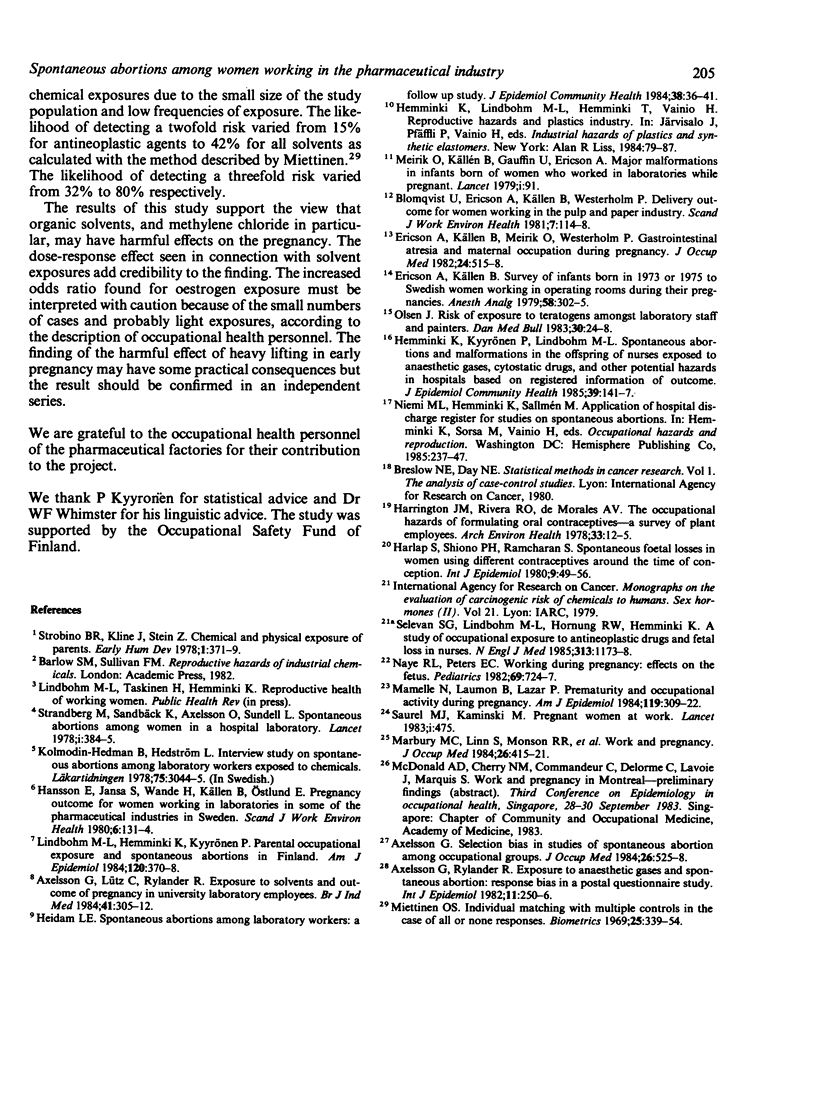
Selected References
These references are in PubMed. This may not be the complete list of references from this article.
- Axelsson G., Lütz C., Rylander R. Exposure to solvents and outcome of pregnancy in university laboratory employees. Br J Ind Med. 1984 Aug;41(3):305–312. doi: 10.1136/oem.41.3.305. [DOI] [PMC free article] [PubMed] [Google Scholar]
- Axelsson G., Rylander R. Exposure to anaesthetic gases and spontaneous abortion: response bias in a postal questionnaire study. Int J Epidemiol. 1982 Sep;11(3):250–256. doi: 10.1093/ije/11.3.250. [DOI] [PubMed] [Google Scholar]
- Axelsson G. Selection bias in studies of spontaneous abortion among occupational groups. J Occup Med. 1984 Jul;26(7):525–528. [PubMed] [Google Scholar]
- Blomqvist U., Ericson A., Källén B., Westerholm P. Delivery outcome for women working in the pulp and paper industry. Scand J Work Environ Health. 1981 Jun;7(2):114–118. doi: 10.5271/sjweh.2558. [DOI] [PubMed] [Google Scholar]
- Ericson A., Källén B., Meirik O., Westerholm P. Gastrointestinal atresia and maternal occupation during pregnancy. J Occup Med. 1982 Jul;24(7):515–518. [PubMed] [Google Scholar]
- Ericson A., Källén B. Survey of infants born in 1973 or 1975 to Swedish women working in operating rooms during their pregnancies. Anesth Analg. 1979 Jul-Aug;58(4):302–305. doi: 10.1213/00000539-197907000-00008. [DOI] [PubMed] [Google Scholar]
- Hansson E., Jansa S., Wande H., Källén B., Ostlund E. Pregnancy outcome for women working in laboratories in some of the pharmaceutical industries in Sweden. Scand J Work Environ Health. 1980 Jun;6(2):131–134. doi: 10.5271/sjweh.2623. [DOI] [PubMed] [Google Scholar]
- Harlap S., Shiono P. H., Ramcharan S. Spontaneous foetal losses in women using different contraceptives around the time of conception. Int J Epidemiol. 1980 Mar;9(1):49–56. doi: 10.1093/ije/9.1.49. [DOI] [PubMed] [Google Scholar]
- Heidam L. Z. Spontaneous abortions among laboratory workers; a follow up study. J Epidemiol Community Health. 1984 Mar;38(1):36–41. doi: 10.1136/jech.38.1.36. [DOI] [PMC free article] [PubMed] [Google Scholar]
- Hemminki K., Kyyrönen P., Lindbohm M. L. Spontaneous abortions and malformations in the offspring of nurses exposed to anaesthetic gases, cytostatic drugs, and other potential hazards in hospitals, based on registered information of outcome. J Epidemiol Community Health. 1985 Jun;39(2):141–147. doi: 10.1136/jech.39.2.141. [DOI] [PMC free article] [PubMed] [Google Scholar]
- Hemminki K., Lindbohm M. L., Hemminki T., Vainio H. Reproductive hazards and plastics industry. Prog Clin Biol Res. 1984;141:79–87. [PubMed] [Google Scholar]
- Lindbohm M. L., Hemminki K., Kyyrönen P. Parental occupational exposure and spontaneous abortions in Finland. Am J Epidemiol. 1984 Sep;120(3):370–378. doi: 10.1093/oxfordjournals.aje.a113901. [DOI] [PubMed] [Google Scholar]
- Mamelle N., Laumon B., Lazar P. Prematurity and occupational activity during pregnancy. Am J Epidemiol. 1984 Mar;119(3):309–322. doi: 10.1093/oxfordjournals.aje.a113750. [DOI] [PubMed] [Google Scholar]
- Marbury M. C., Linn S., Monson R. R., Wegman D. H., Schoenbaum S. C., Stubblefield P. G., Ryan K. J. Work and pregnancy. J Occup Med. 1984 Jun;26(6):415–421. doi: 10.1097/00043764-198406000-00013. [DOI] [PubMed] [Google Scholar]
- Meirik O., Källén B., Gauffin U., Ericson A. Major malformations in infants born of women who worked in laboratories while pregnant. Lancet. 1979 Jul 14;2(8133):91–91. doi: 10.1016/s0140-6736(79)90136-3. [DOI] [PubMed] [Google Scholar]
- Miettinen O. S. Individual matching with multiple controls in the case of all-or-none responses. Biometrics. 1969 Jun;25(2):339–355. [PubMed] [Google Scholar]
- Naeye R. L., Peters E. C. Working during pregnancy: effects on the fetus. Pediatrics. 1982 Jun;69(6):724–727. [PubMed] [Google Scholar]
- Olsen J. Risk of exposure to teratogens amongst laboratory staff and painters. Dan Med Bull. 1983 Feb;30(1):24–28. [PubMed] [Google Scholar]
- Saurel M. J., Kaminski M. Pregnant women at work. Lancet. 1983 Feb 26;1(8322):475–475. doi: 10.1016/s0140-6736(83)91472-1. [DOI] [PubMed] [Google Scholar]
- Strobino B. R., Kline J., Stein Z. Chemical and physical exposures of parents: effects on human reproduction and offspring. Early Hum Dev. 1978 Feb;1(4):371–399. doi: 10.1016/0378-3782(78)90045-2. [DOI] [PubMed] [Google Scholar]


